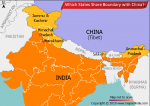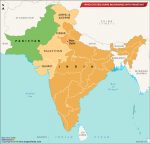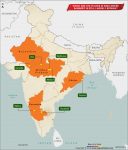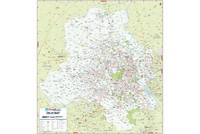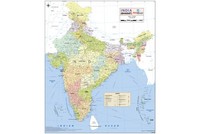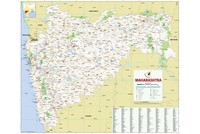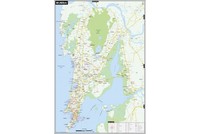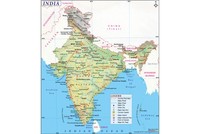On June 19th 1966, the Shiv Sena was founded by Balasaheb Thackeray (also known as Bal Thackeray) in Mumbai.
The Shiv Sena is a Hindu nationalist political organisation founded by Balasaheb Thackeray who was initially a cartoonist with an English daily. In 1960 Thackeray left the English newspaper and founded his own political weekly by the name of Marmik.
Thackeray was immensely inspired by his father Keshav Sitaram Thackeray who was a prominent figure in the Samyukta Maharashtra Movement (United Mahrashtra Movement). This movement, which was at its peak during the 1950’s, demanded the creation of a separate linguistic state of Maharashtra, with Mumbai (then Bombay) as its capital.
In 1947, after the Independence of India, different states, keeping in mind linguistic borders, were created within the country. The Bombay Presidency (as it was known in British India) demanded that a separate state be created for the Marathi speaking people. Bombay Presidency was then divided into the two states of Maharashtra and Gujarat. Mumbai became the state capital of Maharashtra and continues to be an important city in India. Even after this linguistic separation of states, Maharshtra saw a lot of migrants from other states pouring into Mumbai. Most prominent migrants were Gujarati industrialists (many of whom owned businesses in Mumbai) and south Indian professionals who came to the city and took on most management and office administration jobs.
In 1960, Bal Thackeray began publishing cartoons which had a strong anti-migrant undercurrent to them and which primarily targeted Gujarati and south Indian migrants.
On June 19th 1966, Bal Thackeray founded the Shiv Sena (which means "Lord Shiva’s army") in Mumbai as a political organization, though at the time of its formation the Shiv Sena wasn’t active politically. The Shiv Sena became a magnet of sorts for dissatisfied youth who had no jobs, most of who found solace in Thackeray’s anti-migrant sentiments. The Shiv Sena is often remembered for its strong anti-south Indian stance called “pungi bajaao, lungi bhagao”. Members of the Shiv Sena became extremely active in attacking south Indians and in many cases would vandalize establishments run by south Indians and force them to hire Marathis.
In its early years, the Shiv Sena was a strong rival of the communist trade union, who before the formation of the Shiv Sena played an important influence over labour politics in Mumbai. The Indian National Congress supported the Shiv Sena hoping that they would be capable of reducing the effect the communist trade unions had in the city.
It was not long before members of the Shiv Sena got into violent conflicts with communist trade union activists. In 1970, Krishna Desai, the CPI MLA of Dadar was killed and the CPI accused the Shiv Sena of the murder. Bal Thackeray was held responsible for the killing and it is believed that he was relieved of the conviction since he had the support of a powerful industrialist who influenced the decision of the court.
In the 1970s, the Shiv Sena gave more importance to their Right-wing Hindu ideology, with Bal Thackeray making unsavoury moves against Muslims in the state.
In 1995, the Shiv Sena, in a coalition with the BJP, won the Maharashtra state elections and ruled the state from 1995 to 1999 - a tenure during which Thackeray referred to himself as a “remote control” Chief Minister. Following their victory, the Shiv Sena began tweaking their image and held a convention called the Shivsena Rajyapramukh Parishad. This convention called for members to take on new roles as they were now part of the government. It was also the decision of the Shiv Sena to change the name of the capital city from Bombay to Mumbai.
In July 1999, Bal Thackeray was banned from voting and contesting in elections for the next six years, from December 1999 to December 2005. The reason for this ban was that the Election Commission had found Thackeray guilty of corrupt practices and for seeking votes in the name of religion. Thackeray responded by saying that the Shiv Sena had done a lot of good for the Marathi manoos (Marathi people) and believed that Hindus must strive against those who oppose their religion and identity as Hindus. Critics of Thackeray said that he hadn’t done much to combat the problem of unemployment rampant among Marathi youth during his tenure.
After the 2004 Lok Sabha elections, the Shiv Sena lost its strong foothold in Mumbai and began paving a way for itself in the interior parts of Maharashtra.
Narayan Rane, a member of the Shiv Sena, who questioned the decision of Uddhav Thackeray being made the working president of the party, was expelled in July 2005. In December of the same year, Raj Thackeray, Bal Thackeray’s nephew, left the party and formed his own party called the Maharashtra Navnirman Sena (MNS). Even though Uddhav Thackeray was made the party’s leader in 2004, Bal Thackeray remained the chief of the party and continued to make all important decisions.
The Shiv Sena claim to have helped in social emancipation, including assisting the residents of the Dharavi slums in Mumbai (Asia’s largest slums). The Sthaniya Lokadhikar Samiti, an affiliate of the Shiv Sena, supported the cause of Maharashtrians having the right to employment in the state.
During his last days, Bal Thackeray could not look into the day-to-day administering of the Shiv Sena and his son Uddhav Thackeray took over. Bal Thackeray passed away due to a cardiac arrest on November 17th 2012 in Mumbai.
Bal Thackeray’s death saw the city of Mumbai come to a complete halt. Businesses downed shutters and people took to the streets in mourning. The security in the state of Maharashtra was put on high alert. Thackeray was given a state funeral and his cremation took place on November 18th 2012. It is believed that close to two million people attended his funeral, including senior members of the Maharashtra government. Thackeray’s funeral was also broadcast live on national TV channels.
Bal Thackeray has been satirised in works of fiction like Booker Prize-winning author Salman Rushdie's 1995 novel The Moor's Last Sigh. Thackeray was also interviewed by writer Suketu Mehta for his critically acclaimed non-fiction book Maximum City (2004). The 2005 Bollywood film Sarkar, starring Amitabh Bachchan, is supposedly based on the life of Bal Thackeray.
Following Thackeray’s death, Uddhav Thackeray continues to be the Karyapramukh (chief) of the Shiv Sena and his son Aditya Thackeray is the youth leader of the party.
Also On This Day:
1979 - Morarji Desai resigns after split in Janata Party
1981 - APPLE, India's first three-axis stabilized experimental Geostationary communication satellite, is launched by the Indian Space Research Organization.

